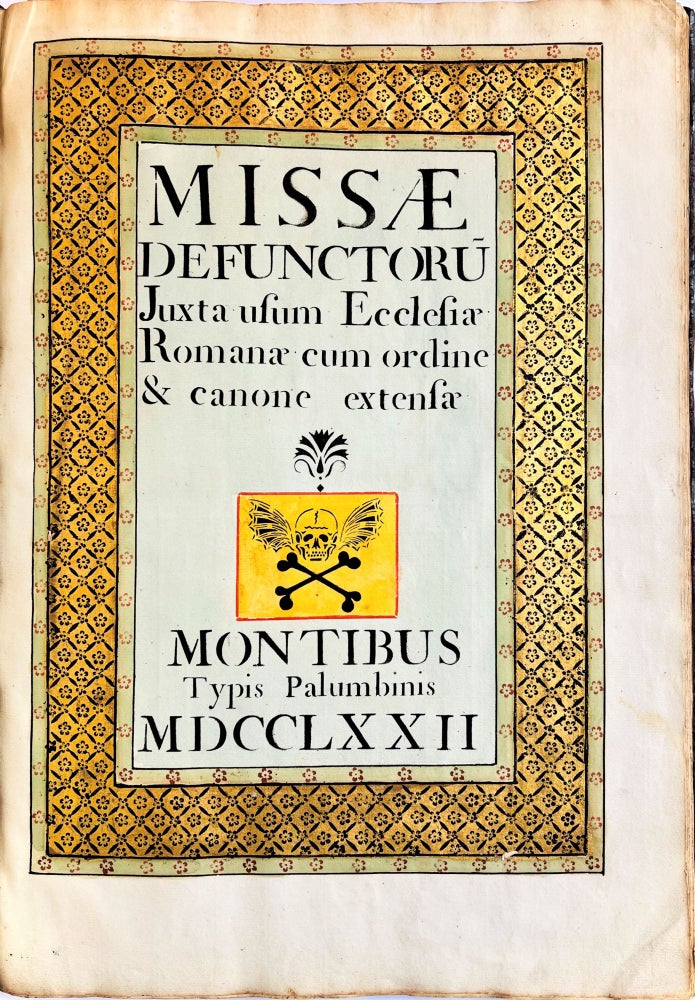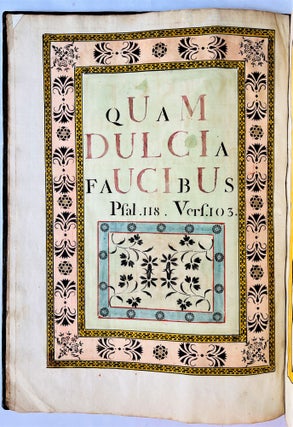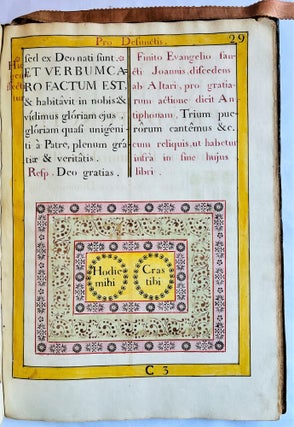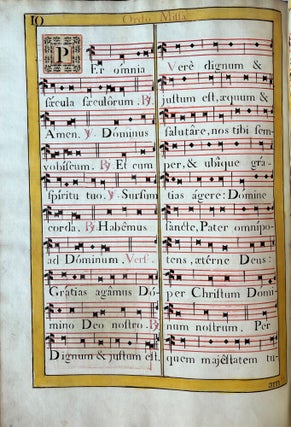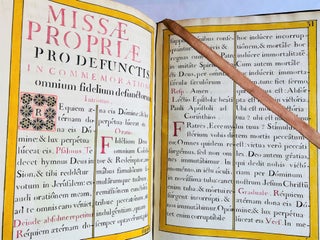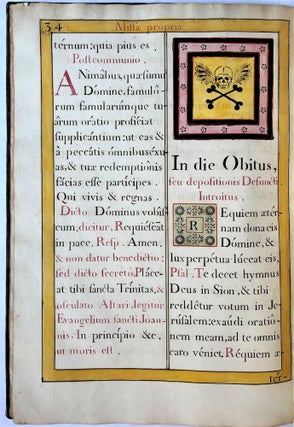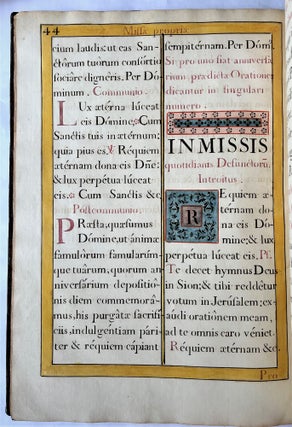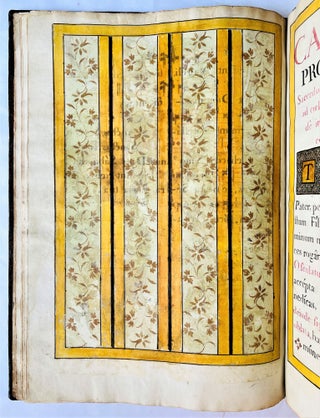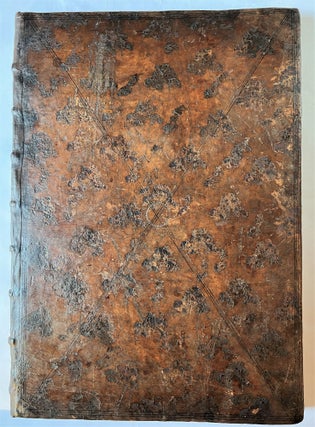Missae defunctorum. Juxta usum Ecclesiae Romanae cum ordine & canone extensae. Mons: Typis Palumbinis (colophon: Ex Officina Palumbina), 1772.
Large folio (524 x 369 mm). Collation: pi1 A-E6 F4 (F4 blank). [1] leaf, 65 pages. Stencil-printed throughout, on thick laid paper; crowned fleur-de-lis watermark. Text of the Mass (pp. 1-49) in two columns, the second part, Orationes diversae, in one column, letters in red and black, two-line capitals in red, running titles in red, pagination in black, yellow page borders and column dividers throughout. Occasional intralinear or marginal insertions. Collational signatures as above, catchwords on rectos and versos of most leaves. Five pages with stencilled music (plainchant) on four-line red staves. Decoration: title within liquid gold border edged in pale green bands with allover design of repeated five-petalled flowers, printed in red on the green bands and in black within a grid on the gold frame, title vignette of a bat-winged skull and crossbones on a yellow ground; two full-page decorations: title verso within stencilled ornamental frame in pink wash edged in yellow bands, central panel in pale green wash with the text of Psalms 118:103 (Quam Dulcia Faucibus [meis]) lettered in black and red capitals, those in red larger, forming a chronogram of the date 1772, below an ornamental floral vignette within a blue frame with repeated spiraling circles; abstract full-page design (p. 12, facing the first Canon page) of yellow vertical bands separating panels of delicate flowers and leafy sprays in light brown on a gray-green ground; 8 large ornamental passepartout initials and 9 ornamental vignettes or bandeaux, the stencilled ornaments printed in black or brown, most on variously colored wash grounds (pale green, pink, blue, yellow, and occasionally brown); including a repeat (p. 34) of the skull and crossbones stencil used on the title. A few small ornaments used as line-fillers in text. Condition: Some dust-soiling, occasional offsetting, full-page decoration on p. 12 with rubbed areas, last two pages browned, first text leaf a bit creased, small repairs to upper corners of first two leaves. Binding: contemporary mottled calf over wooden boards, sides blind-panelled with intersecting diagonal fillets, circular ornament at center of both covers, original pink silk ribbon marker (rebacked, some other small restorations). Provenance: produced in Mons, Belgium, in an unidentified monastic house; Paul-Antoine-Hermand Wins (1760-1834), curé of the parish of Saint Elizabeth and canon of the cathedral of Tournay, sale, Mons, 16 February 1835 (Blogie I, p. 32, online), lot 1388 (described as a manuscript).***
This fine large Requiem Mass book, preserved in its original binding, was stencil-printed in Mons, Belgium, in an atelier called the “Officina Palumbina,” probably based within a monastery. The text of the Mass is interspersed with instructions for the officiating cleric printed in red, followed by various related prayers, including for deceased fellow clergy, arranged by hierarchical order of the defunct, from the Pope down to the mother and father of the priest. The discreet decorative elements, which include gold highlighting for the title, two full-page decorations, and borders and vignettes with meticulous arrangements of small floral, arabesque, abstract and foliate stencils, heighten the visual appeal of an easy to read large format liturgical book, intended no doubt for novices and other relative newcomers to the frequently performed Mass for the Dead.
Stencilled liturgical books were produced in European monastic institutions from the late 17th through the 19th century, but they have received little formal study. Produced using small tin sheets with cut-out letterforms and ornamental forms, such stencilled books were easier and quicker to produce than manuscripts. The process was often used for choir books, but also, as here, to acquaint novices with liturgy and “with the requirements of the Opus Dei” (Schrott). Stencilling for liturgical books may have originated in the mid-17th century (at least that was the theory of Giles Fitteau des Billettes, who wrote the “pochoir” article on the process in the Description des Arts et Métiers, ca. 1700). Des Billettes noted that stencil-printing was used to produce the books needed for particular churches and convents, as opposed to religious books of more general application. It appears that the regular use of stencilling in monastic settings originated in France, and spread throughout Catholic Europe.
Stencilled liturgical books were often not kept in the libraries of the monasteries, but instead tended to be housed with the cantor (Schrott, p. 1). This meant that many did not enter the book trade during the secularizations of the late 18th century. Many were discarded, and those that did survive were often poorly catalogued, being usually incorrectly identified as manuscripts.
In this imposing example the finesse of the decoration, the generally excellent alignment and well-planned layout of the text, and the very existence of the imprint point to its production in a dedicated stencilling workshop used to produce choir books and other large liturgical books, presumably within a monastery, which I have unfortunately been unable to identify. The colophon displays in large capitals the words Labore et Constantia (a motto also used by Plantin). The stencil-printer borrowed all the convetions of a printed book, from the imprint and colophon to the signatures and catchwords and the ornamental initials. More unusual, however, is the purely decorative page facing the opening of the Canon, which evokes a Japanese screen, or wallpaper.
Although the Officina Palumbina’s production was presumably copious, internet searching locates only one other stencilled book with the “Typis Palumbinis” imprint (a choir book dated 1774, with plainchant compositions by several composers, including the monk-composer Paul Damance, preserved in the library of the Archbishopric of Tournai). This large Mass of the Dead is thus a rare survivor of what must have been a thriving center of book production, deserving of further study.
This book’s former owner, Paul-Antoine-Hermand Wins, had been charged, as a young man, with finding books for the library of his superior Cornelius Nelis, Bishop of Antwerp and librarian of Louvain University. Wins used his buying trips to build up his own book collection at the same time, with apparent success, as it took up nearly 2100 lots in the sale catalogue published after his death.
G. Schrott, “Schablonierte Choralbücher. Buchgeschichtliche Entdeckungen auf den zweiten Blick,” in: Ordensgeschichte. Ein interdisziplinäres Gemeinschaftsblog zur Geschichte von Klöstern und Orden, 2019 (online). See generally Eric Kindel, Stencil: a descriptive bibliography, Reading: Éditions à jour, 2019.
No longer available
Status: On Hold

